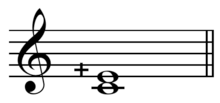Ditone


In music, a ditone (Latin: ditonus, from Ancient Greek: δίτονος, "of two tones") is the interval of a major third. The size of a ditone varies according to the sizes of the two tones of which it is compounded. The largest is the Pythagorean ditone, with a ratio of 81:64, also called a comma-redundant major third; the smallest is the interval with a ratio of 100:81, also called a comma-deficient major third.[1]
Pythagorean tuning
The Pythagorean ditone is the major third in Pythagorean tuning, which has an interval ratio of 81:64,[2] which is 407.82 cents. The Pythagorean ditone is evenly divisible by two major tones (9/8 or 203.91 cents) and is wider than a just major third (5/4, 386.31 cents) by a syntonic comma (81/80, 21.51 cents). Because it is a comma wider than a "perfect" major third of 5:4, it is called a "comma-redundant" interval.[3] ![]() Play
Play
"The major third that appears commonly in the [Pythagorean] system (C–E, D–F♯, etc.) is more properly known as the Pythagorean ditone and consists of two major and two minor semitones (2M+2m). This is the interval that is extremely sharp, at 408c (the pure major third is only 386c)."[4]
It may also be thought of as four justly tuned fifths minus two octaves.
The prime factorization of the 81:64 ditone is 3^4/2^6 (or 3/1 * 3/1 * 3/1 * 3/1 * 1/2 * 1/2 * 1/2 * 1/2 * 1/2 * 1/2).
Just intonation
In Didymus's diatonic and Ptolemy's syntonic tunings, the ditone is a just major third with a ratio of 5:4, made up of two unequal tones—a major and a minor tone of 9:8 and 10:9, respectively. The difference between the two systems is that Didymus places the minor tone below the major, whereas Ptolemy does the opposite.[5]
Meantone temperament
In meantone temperaments, the major tone and minor tone are replaced by a "mean tone" which is somewhere in between the two. Two of these tones make a ditone or major third. This major third is exactly the just (5:4) major third in quarter-comma meantone. This is the source of the name: the note exactly halfway between the bounding tones of the major third is called the "mean tone".[6]
Equal temperament
Modern writers occasionally use the word "ditone" to describe the interval of a major third in equal temperament.[7] For example, "In modern acoustics, the equal-tempered semitone has 100 cents, the tone 200 cents, the ditone or major third 400 cents, the perfect fourth 500 cents, and so on. …”[8]
See also
Sources
- ↑ Abraham Rees, "Ditone, Ditonum", in The Cyclopædia, or Universal Dictionary of Arts, Sciences, and Literature. In Thirty-Nine Volumes, vol. 12 (London: Longman, Hurst, Rees, Orme, & Brown, 1819) [not paginated].
- ↑ James Murray Barbour, Tuning and Temperament: A Historical Survey (East Lansing: Michigan State College Press, 1951): v. Paperback reprint (Mineola, NY: Dover Books, 2004). ISBN 978-0-486-43406-3.
- ↑ Abraham Rees, "Inconcinnous", in The Cyclopædia, or Universal Dictionary of Arts, Sciences, and Literature. In Thirty-Nine Volumes, vol. 13 (London: Longman, Hurst, Rees, Orme, & Brown, 1819) [not paginated].
- ↑ Jeffrey T. Kite-Powell, A Performer's Guide to Renaissance Music, second edition, revised and expanded; Publications of the Early Music Institute (Bloomington and Indianapolis: Indiana University Press, 2007), p.281. ISBN 978-0-253-34866-1.
- ↑ James Murray Barbour, Tuning and Temperament: A Historical Survey (East Lansing: Michigan State College Press, 1951): 21. Paperback reprint (Mineola, NY: Dover Books, 2004) ISBN 978-0-486-43406-3.
- ↑ Mimi Waitzman, "Meantone Temperament in Theory and Practice", In Theory Only 5, no. 4 (May 1981): 3–15. Citation on 4.
- ↑ Anonymous, "Ditonus", The New Grove Dictionary of Music and Musicians, second edition, edited by Stanley Sadie and John Tyrrell (London: Macmillan Publishers, 2001).
- ↑ Manuel Pedro Ferreira, "Proportions in Ancient and Medieval Music", in Mathematics and Music: A Diderot Mathematical Forum, edited by Gerard Assayag, Hans Georg Feichtinger, and José Francesco Rodrigues, 1–17 (Berlin, Heidelberg, and New York: Springer, 2002): 5. ISBN 3540437274.
| ||||||||||||||||||||||||||||||||||||||||||||||||||||||||||||